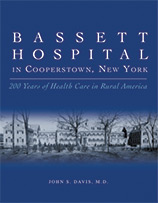Letters
 More History
More History
I was pleased by the inclusion of the Mary Imogene Bassett Hospital in “P&S History, 250 years, Organizational Milestones” (Spring/Summer 2017 Columbia Medicine), documenting Bassett as “the first P&S teaching affiliate outside New York City” in 1947.
In fact, the association of Bassett with P&S goes back much further: Dr. Arthur W. Cutler had received his MD from P&S in 1896. As a surgeon at the A.O. Fox Memorial Hospital in Oneonta, N.Y., he was appointed as consulting surgeon to Bassett Hospital when it opened in 1922 (he died of tuberculosis in 1924).
When a transformed Bassett reopened in 1927, its director was James Greenough, MD, picked as a “rising star” of the P&S faculty. Greenough instituted a full-time, salaried model for the physician staff, highly unusual for the day. He was succeeded by a distinguished internist from P&S, George Miner Mackenzie, MD, who, during his 17 years as director, led Bassett’s evolution into a unique rural academic medical center.
An informal affiliation of Bassett Hospital with P&S, beginning in 1931, brought its medical students to Cooperstown for highly popular summer rotations. By 1936, many conversations between Dr. Mackenzie and the P&S dean, Willard C. Rappleye, MD, had strengthened the informal arrangement. In 1947 it was finally changed to the formal affiliation giving Bassett faculty P&S academic rank for teaching its medical students.
The affiliation has since thrived, including a period of years when Bassett senior surgery residents rotated to P&S. In 2003 Bassett’s Henry F.C. Weil’86 formulated the concept of Bassett becoming a medical school campus. This led seven years later to a new medical-school application track, the Columbia-Bassett Program, separate from Columbia’s traditional medical school curriculum, as described in depth in the Fall 2012 issue of Columbia Medicine. The program got underway in 2010 with Bassett’s physician-in-chief emeritus, Walter A. Franck’64, appointed as associate dean at Bassett Healthcare and Dr. Weil appointed as assistant dean. The program continues to flourish.
All of this information is expanded in my 364-page book, “Bassett Hospital in Cooperstown, New York, 200 Years of Health Care in Rural America,” published by Bassett Healthcare Network in 2016 (ISBN: 978-0-578-19086-0).
John S. Davis, MD
Attending physician and director of medical education emeritus, Bassett Medical Center
Clinical Professor Emeritus of Medicine, P&S
Taking a Position
Though the early 60s were a time of great moral issues in our country—civil rights, Vietnam—as a student at P&S I avoided taking positions. Now retired, I am aware of our country’s new moral issues, including the question of the government’s role in ensuring health care for all its citizens. That one I am taking a position on and wondering why it is not (that I have seen) being addressed in Columbia Medicine. Shouldn’t doctors, of all people, be speaking out?
Daniel C. Bryant’65
Cape Elizabeth, Maine
P&S Leaders Throughout History
I was quite surprised that the name of Dr. Aura Severinghaus was not included in the table of P&S leaders since 1767 in the Columbia Medicine Spring/Summer 2017 edition. It was to Dean Severinghaus that I hopefully turned in my quest for medical school acceptance while I was on a WHO mission in Samoa. His open willingness to consider my application after 10 years away from graduation at Columbia College paved the way for my 50-year career as a developmental pediatrician. Perhaps his many years developing medical education in China opened his heart to my cause. I can do no less now than to hope that his leadership at P&S will be appropriately recognized as we celebrate its 250th anniversary.
Alfred L. Scherzer’63
Clinical Professor Emeritus of Pediatrics
Weill Cornell Medical College
Editor’s Note: The list Dr. Scherzer refers to documented the medical school deans throughout P&S history. Dr. Severinghaus was associate dean and chair of the admissions committee from 1942 until his retirement in 1963. “In this post he seemed to find his greatest satisfactions, for he was close to almost every medical student, from the student’s first preadmission interview through the four student years to the choice of internship and specialty,” reported his obituary in the New York Times.
Middle East Higher Learning
The article reporting the excellent work of Fadlo Khuri’89 (Spring/Summer 2017) states, “the American University of Beirut, the oldest and arguably the most respected institution of higher learning in the Middle East...” I have no quibble with the claim to its being the oldest nor do I wish to denigrate Dr. Khuri or his colleagues there. However, if we are going to use evidence-based criteria, then according to the World University Rankings 2017, the most respected institution of higher learning in the Middle East is in fact in Israel.
Robert D. Wagman’81
Toronto
- Log in to post comments

